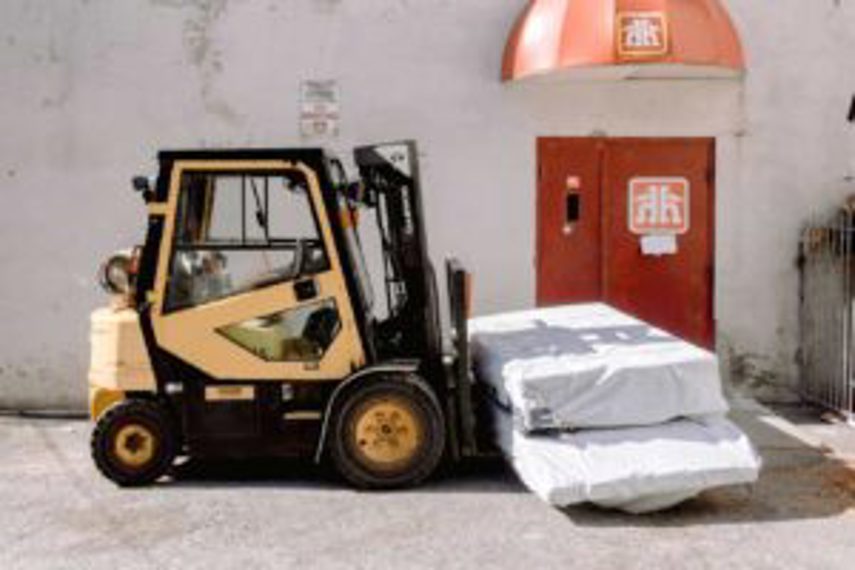
How is the logistics and supply chain management industry evolving – and what developments do you need to consider?
We’ve read the market reports, interviewed the key stakeholders, and identified the most important areas of change. Here we break these down for you with 10 of the major trends in this industry for 2024 and beyond.
Manufacturers holding double stock
In step with global predictions that the Just in Time model is evolving into more of a 'Just in Case' supply chain, 2022 research by Unleashed has found the volume of stock held by manufacturers doubled from 2021–2022.
Analysis of Stock on Hand data from a sample of 521 mid-sized manufacturers in the UK revealed that – across sectors – firms were increasing their inventory by over 34%, without a similar lift in turnover.
“A combination of labour constraints as an effect of the Covid-19 pandemic, on-going challenges from Brexit and pressure on packaging and raw material inputs has seen our business move from a shallow just-in-time stock holding, to instead holding a buffer of over four weeks of cover to allow for delays within our supply chain,” said one manufacturer interviewed in the study.
“We don’t see a return to the ‘just-in-time’ model. Our planning for 2023-25 sees us ensuring flexibility in our supply chain to scale up quickly and hold additional weeks of cover to compensate for demand peaks.”
Inflation and supply chain disruptions continue to accelerate
Despite the pandemic sitting comfortably in our rearview, supply chain disruptions continue to occur more frequently than normal. This could be a result of materials scarcity, a tightening of border security worldwide, and the rising costs of logistics and operations.
Speaking of rising costs, consumers are feeling the effects of inflation as 2022 retail prices in the US suffered the highest increase year-over-year in the last 40 years: up by 9.1% according to Forbes. It was even worse in Europe, where inflation was running at 10.7% in October 2022. Many businesses will now be pushing towards more efficient systems capable of dealing with supply chain disruptions and rising costs.
Supplier relationships are expected to hold higher value in 2024, as retailers and wholesalers seek to shorten lead times and increase bulk discounts.
 Fostering a mutually beneficial relationship with your suppliers is important for maintaining stability in times of economic disruption.
Fostering a mutually beneficial relationship with your suppliers is important for maintaining stability in times of economic disruption.
Cloud technology continues to command a seat at the table
Cloud technology in logistics and supply chain management certainly isn’t a new trend, but thanks to Covid-19 it’s seen a boom since 2020 and will likely continue to experience increased popularity as we move into 2024 and beyond.
The cloud industry as a whole has seen enormous success, with a compound annual growth rate of 13.1% leading to an expected market size of US$881.8 billion by 2027. A surge in big data consumption, digital transformation and adoption of 5G has all contributed to this monumental growth, and the further development of AI and internet of things (IoT) technology will contribute further.
The cloud technology boom will impact SMEs more than large brands
Grand View Research predicts that digital transformation will impact SMEs most of all, as the cost of cloud technology keeps falling – enabling more and more companies to access advanced software such as data analytics, ERP, inventory management, CRM, and accounting software.
Logistics firms must also think about eCommerce
Self-improvement technologies like ERP or inventory management are one thing, but organisations in logistics and supply chain management must also look to technologies that better connect them to customers too – namely, B2B e-commerce tools.
- Fact: Ecommerce is not just for retailers. In fact, Gartner believes that 80% of B2B sales will be done digitally by 2025.
Any B2B business that still relies on sales reps, in-person meetings and phone calls may see itself fall behind as we move through 2024. Gartner’s research shows that when a B2B buyer is comparing options, they’ll only spend about 5% of their time with an individual company’s reps.
Meanwhile, a purpose-built eCommerce platform that puts power in the customer’s hands and makes browsing your products and services a breeze can help improve your competitiveness in 2024.
- Learn more: Unleashed’s B2B e-commerce platform
The Ultimate Supply Chain Management Guide
Methods for Modern Businesses Read More
Last mile as a service
There’s a lot of pressure on the last mile these days, with customers wanting faster, more accurate deliveries at cheaper and cheaper prices.
Brands such as Amazon are generally capable of meeting these demands (remember that 30-minute delivery we mentioned above), which means smaller logistics companies must be able to keep up or else risk losing business.
Third-party logistics (3PL) has been a solution for a number of years, and we expect that some of these providers will pivot their focus more and more onto the last mile by providing last mile as a service (LMaaS).
But LMaaS is not yet well-established
Many companies are trying to revolutionise the last mile, which means we’re seeing a few different business models popping up into the market – and sometimes sinking within a few years: the Shyp app is an example of this.
On-demand crowdsourcing is seen as one potential revolutioniser for shipping, using an Uber or AirBnB-like model but for final mile delivery. This has huge potential for dense urban areas, but may not be able to accommodate rural communities.
There are also major brands like Walmart looking to move into the space, offering services like Walmart GoLocal for white label delivery. Theoretically this enables smaller companies to access the logistics capabilities of major brands but – as with on-demand services – it is a potential competitor to existing logistics and supply chain businesses.
What does this mean for the logistics industry?
2024 will be a year of choice. Do you choose to focus your own company on providing a high-value last mile delivery service – or do you abandon this and allow a third-party to handle it for you? Given the focus on this area, and the expectations of the customer, there may not be a third option.
This is definitely a trend to watch for in the coming years.
 Last-mile delivery has become a focus for many businesses - with some companies already using drones to achieve this efficiently.
Last-mile delivery has become a focus for many businesses - with some companies already using drones to achieve this efficiently.
Sustainability still a focus
Sustainability has appeared on lists of supply chain trends before, and it's likely to appear on them for years to come.
COP27 – the annual UN climate change conference – took place in November 2022. Much of the discussion last year revolved around food processing and reducing greenhouse gases in the agriculture and food sectors. An initiative was put in place to reduce these emissions, with over 20 agriculture ministers from around the world contributing.
The reality is undeniable: sustainability in the supply chain is under the microscope and green practices are the future. But the question is: which practices?
The future of electric trucks
We mentioned autonomous trucks above, but what about electric trucks?
The EV trucking industry is expected to grow to US$1,893.1 million by 2027, at a CAGR of 25.8%. This growth is being driven globally by government green initiatives and emissions sanctions.
It’s likely that some type of sustainable trucking alternative will be used in future, but it may not be EVs and it may not be in the next five years. That’s because while the technology is making leaps and bounds in terms of cost versus efficiency, EV infrastructure is lagging behind and the trucks themselves remain prohibitively expensive for many companies.
Examples of sustainability initiatives in logistics & supply chain management
- European Union nations introduce plastic tax on non-recycled plastic packaging.
- Amazon vows to go carbon neutral by 2030.
- Researchers offer solutions to optimise CO2 emissions through smarter vehicle assignment.
Companies optimise for reverse logistics
Returns, end-of-life goods, end-of-lease rentals, and even delivery failures all used to be a lot simpler when shipping areas were smaller, and most companies operated out of brick-and-mortar stores. But our modern age is global, and goods are increasingly bought via eCommerce – which means they must be returned through the same channels.
This is where reverse logistics has grown in importance.
Optimised reverse logistics is essential for any supply chain management company, which must now be able to handle goods flowing back in as efficiently as it can handle goods flowing out.
But there are a great many challenges to this process. For one, businesses need to be able to predict which items are likely to come backwards up the supply chain, and where they are most likely to arrive. If the cost of this outweighs the value of the item, companies lose money. It’s also important that the goods themselves don’t get lost in the process.
 Businesses will increasingly look to streamline their reverse logistics processes and implement circular supply chains in 2022 and beyond
Businesses will increasingly look to streamline their reverse logistics processes and implement circular supply chains in 2022 and beyond
Circular supply chains close the loop
The ‘circular supply chain’ is a hot topic at the moment, particularly when discussing sustainability. A circular supply chain is one where goods that flow in the reverse direction are able to be reused, recycled or resold. If they then flow back up the supply chain again, they can be reused, recycled or resold again – with this process occurring repeatedly.
This closed loop supply chain is likely the future, but not in the short term. We still lack much of the infrastructure required to break down and reuse materials, so even goods which could be recycled – such as certain types of plastic – still go to landfill, despite best intentions.
It’s likely we won’t see any major changes to this loop in 2024, but we will see more steps taken towards its realisation. That means companies in logistics must continue to optimise their reverse supply chain functions and keep an eye out for sustainability partners such as packaging manufacturers and recyclers. Being able to advertise these types of green initiatives could prove to be a point of competitive advantage for eco-conscious customers.
Cross docking facilities cut storage costs
What is cross docking? Cross docking is the transfer of inbound goods to an outbound carrier through the use of a cross docking facility – that is, a temporary storage terminal that cuts out or reduces the need for inventory storage. All incoming goods are sorted and loaded onto outbound trucks as quickly as possible – often immediately.
The cross-docking market is another growth area. Globally it’s expected to reach US$342 billion by 2030 at a CAGR of around 6%. This growth is being fuelled by rising customer expectations for delivery times, putting pressure on logistics through the ‘need for speed’.
Cross docking benefits
- Reduced costs, particularly any costs associated with long-term inventory storage and associated facilities, labour and utilities.
- Improved stock turnover, as the goal of cross docking is to get goods in and out as efficiently as possible.
- Minimised risk, given there’s reduced handling of goods and no long-term storage that could increase the chance of spoilage.
Cross docking challenges
- More carriers are required for a cross docking facility to work efficiently. Too few carriers and goods have to be moved into storage – meaning the cross-docking strategy fails.
- It puts pressure on planning and coordination staff to manage complex shipping schedules and create more accurate forecasts to get goods in and out efficiently.
- Efficient inventory management technology is required to improve the speed of unloading, scanning, sorting and reloading, and to ensure that goods can be tracked throughout the process – and won’t get missed and left behind at the dock.
Learn more: Cross Docking 101: What, Why and How? [with case studies]
 Cross docking is a means of improving delivery times and minimising storage - but requires more carriers and careful planning to run efficiently.
Cross docking is a means of improving delivery times and minimising storage - but requires more carriers and careful planning to run efficiently.
Equipment and vehicles are more automated than ever before
Not so long ago self-guided autonomous vehicles and robots were a thing of science fiction. And then they were the exclusive realm of big-brand global retailers like Amazon.
Now they’re within the grasp of many organisations with a logistics or warehouse function.
- Fact: The global autonomous warehouse robotics market is expected to nearly double in size by 2025, reaching US$27.2 billion.
It’s likely that in 2024 and beyond autonomous vehicles and equipment will increasingly emerge as a key trend in the logistics and supply chain automation sector. Equipment that we’ve seen increasingly automated includes:
- Automated storage & retrieval: Robotic order picking systems and other storage or retrieval technology lets robots find, pick and move inventory around large warehouses – at a much faster rate than humans can and with less risk to safety. One company, Exotec, has already deployed over 2,000 such units around the globe.
- Automated trucking: It’s believed that use of self-driving trucks will be widespread long before self-driving cars. In fact, investor funding for this technology has ballooned since 2017, growing from US$0.1 billion to $5.6 billion in 2021.
- Automated delivery: Delivery drones are the final piece of the logistics puzzle, automating the last mile of delivery using either driving or flying robots. Starship Technologies is a company that uses small, six-wheeled drones to move goods within a small radius, and has completed 2 million deliveries as of 2021. Amazon Prime Air is leading the way in flying drones, offering 30-minute delivery to some customers thanks to this technology.
Robots such as these can offer huge benefits, including increasing safety and automating menial, repetitive tasks – and allowing human workers to focus on other value-adding activities.
 Thanks to falling prices, automation for tasks like storage, retrieval and even delivery is becoming more accessible now for SMEs.
Thanks to falling prices, automation for tasks like storage, retrieval and even delivery is becoming more accessible now for SMEs.
Omnichannel retail means supply chains must keep up
Retailers and other business sectors are going omnichannel. That means their goal is to offer their customers a seamless shopping experience whether they shop in-store, online, via their phones or computers or through social media. No matter the platform, it’s all one experience, rather than siloed channels that don’t work together. Data theoretically transfers from one to the other without obstruction.
The supply chain in some areas isn’t keeping up with this trend, and that will cause tension between parties – especially in this age where customers expect fast delivery.
Digital transformation is key to going omnichannel
Here again digital transformation is key. The logistics and supply chain industry must be able to manage multiple customer channels, fulfilment models, payment options, and even facilities all in a seamless, interconnected way.
This level of synergy between physical and digital systems – and the processes and training required to manage them – sometimes requires significant transformation.
McKinsey identifies seven key building blocks to building an omnichannel supply chain, which involves a blend of process automation, re-evaluated fulfilment networks, customer-centric strategy and change management.
 Keeping up with the omnichannel trend will ensure that your business can manage multiple selling channels and fulfilment models - and compete with larger companies.
Keeping up with the omnichannel trend will ensure that your business can manage multiple selling channels and fulfilment models - and compete with larger companies.
So where to from here for logistics & supply chain management?
When looking at industry trends, there often isn’t a key theme connecting all of them – but here in logistics and supply chain management, there is.
Customers expect better, faster shipping, while keeping prices as low as possible and improving sustainability. This has and will continue to put pressure on every step of the supply chain, requiring significant transformation in almost all facets of the industry.
For any business to compete, especially against large multinationals, our research shows that process optimisation, efficiency and relationship-building will all be critical in 2024 and beyond.
